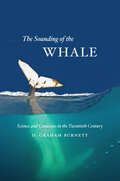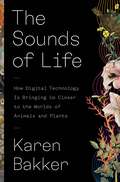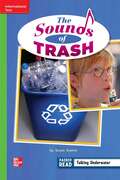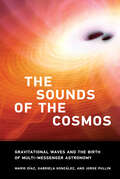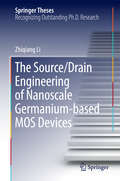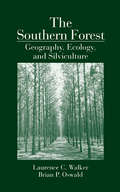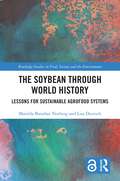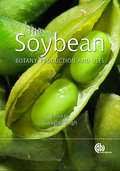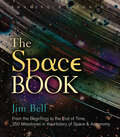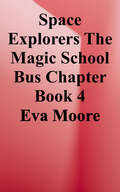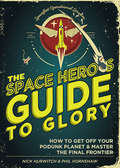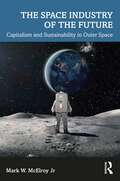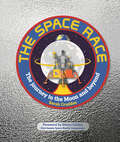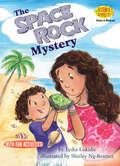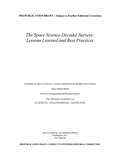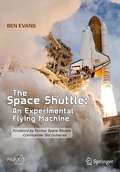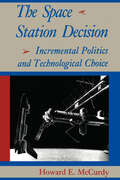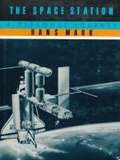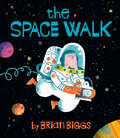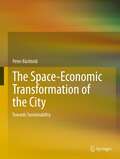- Table View
- List View
The Sound of the Sea: Seashells And The Fate Of The Oceans
by Cynthia BarnettA compelling history of seashells and the animals that make them, revealing what they have to tell us about nature, our changing oceans, and ourselves. Seashells have been the most coveted and collected of nature’s creations since the dawn of humanity. They were money before coins, jewelry before gems, art before canvas. In The Sound of the Sea, acclaimed environmental author Cynthia Barnett blends cultural history and science to trace our long love affair with seashells and the hidden lives of the mollusks that make them. Spiraling out from the great cities of shell that once rose in North America to the warming waters of the Maldives and the slave castles of Ghana, Barnett has created an unforgettable account of the world’s most iconic seashells. She begins with their childhood wonder, unwinds surprising histories like the origin of Shell Oil as a family business importing exotic shells, and charts what shells and the soft animals that build them are telling scientists about our warming, acidifying seas. From the eerie calls of early shell trumpets to the evolutionary miracle of spines and spires and the modern science of carbon capture inspired by shell, Barnett circles to her central point of listening to nature’s wisdom—and acting on what seashells have to say about taking care of each other and our world.
The Sounding of the Whale: Science and Cetaceans in the Twentieth Century
by D. Graham Burnett&“This wonderful book documents the interplays among science, conservation and politics in the evolving career of the whale over the last century.&” —William Perrin, Senior Scientist for Marine Mammals at the Southwest Fisheries Science Center, NOAA Fisheries Service From biblical times, whales have breached in the human imagination as looming figures of terror, power, confusion, and mystery. In the twentieth century, however, our understanding of and relationship to these superlatives of creation underwent some astonishing changes, and with The Sounding of the Whale, D. Graham Burnett tells the fascinating story of the transformation of cetaceans from grotesque monsters, useful only as wallowing kegs of fat and fertilizer, to playful friends of humanity, bellwethers of environmental devastation, and, finally, totems of the counterculture in the Age of Aquarius. When Burnett opens his story, ignorance reigns: even Nature was misclassifying whales at the turn of the century, and the only biological study of the species was happening in gruesome Arctic slaughterhouses. But in the aftermath of World War I, an international effort to bring rational regulations to the whaling industry led to an explosion of global research—and regulations that, while well-meaning, were quashed, or widely flouted, by whaling nations, the first shot in a battle that continues to this day. The book closes with a look at the remarkable shift in public attitudes toward whales that began in the 1960s, as environmental concerns and new discoveries about whale behavior combined to make whales an object of sentimental concern and public adulation. A sweeping history, grounded in nearly a decade of research, The Sounding of the Whale tells a remarkable story of how science, politics, and simple human wonder intertwined to transform the way we see these behemoths from below.
The Sounds of Life: How Digital Technology Is Bringing Us Closer to the Worlds of Animals and Plants
by Karen BakkerAn amazing journey into the hidden realm of nature&’s soundsThe natural world teems with remarkable conversations, many beyond human hearing range. Scientists are using groundbreaking digital technologies to uncover these astonishing sounds, revealing vibrant communication among our fellow creatures across the Tree of Life.At once meditative and scientific, The Sounds of Life shares fascinating and surprising stories of nonhuman sound, interweaving insights from technological innovation and traditional knowledge. We meet scientists using sound to protect and regenerate endangered species from the Great Barrier Reef to the Arctic and the Amazon. We discover the shocking impacts of noise pollution on both animals and plants. We learn how artificial intelligence can decode nonhuman sounds, and meet the researchers building dictionaries in East African Elephant and Sperm Whalish. At the frontiers of innovation, we explore digitally mediated dialogues with bats and honeybees. Technology often distracts us from nature, but what if it could reconnect us instead?The Sounds of Life offers hope for environmental conservation and affirms humanity&’s relationship with nature in the digital age. After learning about the unsuspected wonders of nature&’s sounds, we will never see walks outdoors in the same way again.
The Sounds of the Cosmos: Gravitational Waves and the Birth of Multi-Messenger Astronomy
by Mario Diaz Jorge Pullin Gabriela GonzalezThe remarkable story of how humankind discovered gravitational waves, chronicled with unparalleled historical and scientific vision.In 2016, the LIGO and Virgo Collaborations made headlines when they announced the detection of gravitational waves—a century after Albert Einstein first predicted their existence with his general theory of relativity. With unprecedented perspective as physicists at the forefront of this discovery, Mario Díaz, Gabriela González, and Jorge Pullin provide a comprehensive and accessible account of the quest to find gravitational waves, their controversial history, and the efforts that culminated with their detection and a Nobel Prize in Physics.The Sounds of the Cosmos vividly narrates contributions from the ancient Greeks through Einstein, in addition to the breakthroughs of the twentieth and twenty-first centuries, including the discovery of the Hulse-Taylor binary star system (the first of its kind ever observed) and the technology behind gravitational wave detectors. The authors' fusion of meticulous research and accessible prose makes this book an indispensable resource for the scientifically curious, lending astonishing new context to the revelation that we can &“hear&” the cosmos through gravitational waves. Written with exceptional historical and conceptual insight, this is a definitive and dazzling journey through &“the eternal quest of humankind to understand the universe.&”
The Source/Drain Engineering of Nanoscale Germanium-based MOS Devices
by Zhiqiang LiThis book mainly focuses on reducing the high parasitic resistance in the source/drain of germanium nMOSFET. With adopting of the Implantation After Germanide (IAG) technique, P and Sb co-implantation technique and Multiple Implantation and Multiple Annealing (MIMA) technique, the electron Schottky barrier height of NiGe/Ge contact is modulated to 0. 1eV, the thermal stability of NiGe is improved to 600â,,f and the contact resistivity of metal/n-Ge contact is drastically reduced to 3. 8×10−7Ω*cm2, respectively. Besides, a reduced source/drain parasitic resistance is demonstrated in the fabricated Ge nMOSFET. Readers will find useful information about the source/drain engineering technique for high-performance CMOS devices at future technology node.
The South Carolina Biology Handbook
by Alton Biggs Whitney Crispen Hagins William G. Holliday Chris L. Kapicka Linda Lundgren Marion B. Sewer Ann Haley William D. RogersmackenzieBiology Handtbook
The Southern Forest: Geography, Ecology, and Silviculture
by Laurence C. Walker Brian P. OswaldThe Southern Forest: Geography, Ecology, and Silviculture examines the forests of the South, providing a comprehensive description of the region from which most of the nation's wood for housing and paper will be grown and harvested in the future. It gives special attention the four factors of site - edaphic, biotic, climatic, and physiographic. It also includes over 200 photographs, an extensive listing of literature citations, and appendixes of tree, insect, and disease agents. With files of field notes and photographs, it takes the reader along to grasp the South's rich forests. Land managers will need no other reference to the soils, biotic components, climate or physiology of the region.
The Southern Sky Guide
by Wil Tirion David EllyardThis unique and accessible book provides a handy reference to the skies visible from the countries of the southern hemisphere. Amateur astronomers or casual observers of the night sky will have easy access to the star charts of world famous astronomical cartographer Wil Tirion, prepared especially for this volume. Television astronomer David Ellyard has contributed a detailed explanatory text to accompany the charts, together with a general introduction to the study of the night sky. Charts of the whole sky - 24 in all - show what is visible early and late in each month. These are followed by details of each section of the sky, with particular attention to the constellations seen in the southern skies. For this new edition, the text has been thoroughly revised and new charts created to illustrate the legends behind the main constellations. Planet positions are provided up to 2010.
The Soviet Union and Communist China 1945-1950: The Arduous Road to the Alliance
by Dieter HeinzigDrawing on a wealth of new sources, this work documents the evolving relationship between Moscow and Peking in the twentieth century. Using newly available Russian and Chinese archival documents, memoirs written in the 1980s and 1990s, and interviews with high-ranking Soviet and Chinese eyewitnesses, the book provides the basis for a new interpretation of this relationship and a glimpse of previously unknown events that shaped the Sino-Soviet alliance. An appendix contains translated Chinese and Soviet documents - many of which are being published for the first time. The book focuses mainly on Communist China's relationship with Moscow after the conclusion of the treaty between the Soviet Union and Kuomingtang China in 1945, up until the signing of the treaty between Moscow and the Chinese Communist Party in 1950. It also looks at China's relationship with Moscow from 1920 to 1945, as well as developments from 1950 to the present. The author reevaluates existing sources and literature on the topic, and demonstrates that the alliance was reached despite disagreements and distrust on both sides and was not an inevitable conclusion. He also shows that the relationship between the two Communist parties was based on national interest politics, and not on similar ideological convictions.
The Soybean Through World History: Lessons for Sustainable Agrofood Systems (Routledge Studies in Food, Society and the Environment)
by Matilda Baraibar Norberg Lisa DeutschThis book examines the changing roles and functions of the soybean throughout world history and discusses how this reflects the complex processes of agrofood globalization. The book uses a historical lens to analyze the processes and features that brought us to the current global configuration of the soybean commodity chain. From its origins as a peasant food in ancient China, today the protein-rich soybean is by far the most cultivated biotech crop on Earth; used to make a huge variety of food and industrial products, including animal feed, tofu, cooking oil, soy sauce, biodiesel and soap. While there is a burgeoning amount of literature on how the contemporary global soy web affects large tracts of our planet’s social-ecological systems, little attention has been given to the questions of how we got here and what alternative roles the soybean has played in the past. This book fills this gap and demonstrates that it is impossible to properly comprehend the contemporary global soybean chain, or the wider agrofood system of which it is a part, without looking at both their long and short historical development. However, a history of the soybean and its changing roles within equally changing agrofood systems is inexorably a history about globalization. Not only does this book map out where soybeans are produced, but also who governs, wields power and accumulates capital in the entire commodity chain from inputs in production to consumption, as well as identifying the institutional context the global commodity chain operates within. The book concludes with a discussion of the main challenges and contradictions of the current soy regime that could trigger its rupture and end. This book is essential reading for students, practitioners and scholars interested in agriculture and food systems, global commodity chains, globalization, environmental history, economic history and social-ecological systems.
The Soybean: Botany, Production and Uses
by Guriqbal SinghThis book covers all aspects of soybean, a significant crop. Chapters discuss the history and importance of soybean production in agriculture followed by details of the plant's physiology and developments in breeding and genetics. The diverse cropping systems used in production are highlighted alongside crop management and protection strategies. Technology for processing and utilization, soybean's nutritional value and the outlook for global marketing and trade are also addressed.
The Space Book Revised and Updated: From the Beginning to the End of Time, 250 Milestones in the History of Space & Astronomy (Union Square & Co. Milestones)
by Jim BellA revised and updated edition of the successful book, now featuring the most recent discoveries, technologies, and images. Since the original edition of The Space Book was published in 2013, much has happened in the world of space exploration. This revised and updated edition, with a new introduction from author Jim Bell, brings the popular Milestones book up to date. It includes the most exciting and newsworthy breakthroughs, from the groundbreaking discovery of the Trappist-1 system to the technologies of the future. Take a full-color, chronological tour of the cosmos through completely new entries and spectacular images that cover developments in radio astronomy, NASA&’s mission to Jupiter, the new Earth-like exoplanets, the world&’s first interstellar solar sail mission, and more. Many existing entries have been updated with the results of completed and current missions, as well as illuminating recent photography.
The Space Explorers (The Magic School Bus Chapter Book #4)
by Eva MooreThe Magic School Bus blasts off on a tour of the Milky Way planets, and the kids discover how the other planets are different from Earth. Not only do they all have different temperatures, but each planet has a different atmosphere as well. Ms. Frizzle's class finds out how far away the planets are, and how long it would really take to get there if they didn't have a Magic School Bus.
The Space Hero's Guide to Glory
by Phil Hornshaw Nick HurwitchThink every space hero was born with an army of laser-firing minions? Think it's easy to maintain a healthy rivalry with your archnemesis? Think again!Intergalactic News Flash: Even a rookie like yourself can become the next great Space Hero. But there's more to it than seducing alien babes or swapping one-liners with our first mate. How will you combat the evils of helmet hair? Can you win a no-win scenario? If you want to survive the 'Verse, you've got a lot to learn, Cadet.The Space Hero's Guide to Glory is a step-by-step illustrated guide that will take you from home world half-wit to interstellar idol. Filled with lessons gleaned from your legendary predecessors--including Han Solo, Captain Kirk, and Kara Thrace--you'll learn the difference between laser and phaser, how to assemble a crew of brilliant misfits, and the basic piloting skills to avoid warping your starship straight into a black hole.So suit up and get reading, Cadet. Space needs its next Space Hero!
The Space Industry of the Future: Capitalism and Sustainability in Outer Space
by Mark W. McElroy JrThe Space Industry of the Future consists of the first instance of guidance for the space industry on how value creation in space can occur for the greater benefit of humanity using principles of capitalism and sustainability. The timing of this book is ideal given (1) sustainability challenges facing humanity and (2) that the growth of the commercial space economy is now occurring at a rate never seen before. This book presents an opportune guide written for technical, business, and policy practitioners alike that frames how this industry growth should occur from an integrated values and commercial perspective. This perspective is presented in the context of the modern technical capabilities of space systems relative to the world’s greatest problems. The guidance contained in this book for the growing commercial space industry includes considerations beyond profit seeking alone. This guidance is founded on a bespoke value creation criteria to apply in the context of for-profit outer space activities that, if used, will result in the maximum value creation that a company is capable of. The criteria are developed and presented through a rigorous discussion on capitalism, economics, value theory, the circular economy, stakeholder management, and ethics. The value creation criteria are then discussed at length in relation to the space industry. The primary audience for this book is practitioners within the space industry; this includes investors, business managers, policy makers, engineers, and scientists. The secondary audience includes students and researchers, as well as a growing range of parties interested in space policy and entrepreneurship.
The Space Race: The Journey to the Moon and Beyond
by Sarah CruddasBlast off alongside space expert Sarah Cruddas on a ride-along through space exploration history with interviews from real astronauts!This children&’s space handbook takes you on a journey through the history of space exploration. Unpack space history, its future, and fascinating information on human exploration of our galaxy. This picture ebook will answer your kid's planet-sized questions.Suited for space-intrigued 7-9-year old&’s who are eager to learn about the galaxy! This children's ebook includes a foreword by NASA astronaut Eileen Collins, the first woman to command a space shuttle mission. Learn about real-life astronauts, including Apollo 17&’s Eugene Cernan and Virgin Galactic Test Pilot Kelly Latimer, who both give us insights about life in space! From man's dream on Earth about going into space to man&’s first steps on the moon and beyond, satisfy your interest of space by immersing yourself in first-hand thought-provoking stories and jaw-dropping visuals of this high quality, content-rich educational ebook. Read about the hidden stories behind the most famous space missions, before embarking on a journey through our space future. Propelled by recent scientific discoveries and printed to coincide with the 50th anniversary of the Apollo 11 Moon landing, The Space Race is an essential children's handbook to understanding every aspect of the history, and future, of human space travel.Track Our Incredible Human Journey Through The Cosmos Track our incredible human journey through the cosmos. Delve into 50 years of space exploration with Sarah Cruddas, who shares exciting first-hand experiences of real astronauts and milestone events. How did we land on the Moon? What will the space jobs of the future look like? And why did we send a car to space? The Space Race answers all of the big questions that kids have about space travel.Let your children explore their own questions with factual content that will leave them captivated and perhaps, who knows, want to become an astronaut too someday?This educational space ebook takes you on a journey through:- History of the race to the moon- Trailblazers in space exploration- The new space race - The future of space innovation
The Space Rock Mystery: Rocks And Minerals (Science Solves It!)
by Lydia LukidisSolve kid-sized dilemmas and mysteries with SCIENCE SOLVES IT! These fun science books for kids ages 5–8 blend clever stories with real-life science. Why did the dog turn green? Can you control a hiccup? Is that a UFO? Find the answers to these questions and more as kid characters dive into physical, life, and earth sciences. "This rock is totally from outer space!" At least that&’s what Kaleo thinks when he picks up an amazing rock on the beach. Finding out more will lead him and his sister, Leia, on an adventure they&’ll never forget! Books in this perfect STEM series will help kids think like scientists and get ahead in the classroom. Activities and experiments are included in every book!
The Space Science Decadal Surveys: Lessons Learned and Best Practices
by Committee on Survey of Surveys: Lessons Learned from the Decadal Survey ProcessThe National Research Council has conducted 11 decadal surveys in the Earth and space sciences since 1964 and released the latest four surveys in the past 8 years. The decadal surveys are notable in their ability to sample thoroughly the research interest, aspirations, and needs of a scientific community. Through a rigorous process, a primary survey committee and thematic panels of community members construct a prioritized program of science goals and objectives and define an executable strategy for achieving them. These reports play a critical role in defining the nation's agenda in that science area for the following 10 years, and often beyond. "The Space Science Decadal Surveys" considers the lessons learned from previous surveys and presents options for possible changes and improvements to the process, including the statement of task, advanced preparation, organization, and execution. This report discusses valuable aspects of decadal surveys that could taken further, as well as some challenges future surveys are likely to face in searching for the richest areas of scientific endeavor, seeking community consensus of where to go next, and planning how to get there. "The Space Science Decadal Surveys" describes aspects in the decadal survey prioritization process, including balance in the science program and across the discipline; balance between the needs of current researchers and the development of the future workforce; and balance in mission scale - smaller, competed programs versus large strategic missions.
The Space Shuttle (Springer Praxis Books)
by Ben EvansThis book explains how the achievements of the Space Shuttle, the world’s first reusable manned spacecraft, were built on the foundation of countless technical challenges. <p><p> Through thick and thin, the Space Shuttle remained the centerpiece of the American human spaceflight program for three decades. In addition to deploying satellites, planetary probes and, of course, the Hubble Space Telescope, it delivered astronauts to the Mir space station and assembled and sustained the International Space Station. Yet the path to these incredible achievements was never an easy one, with some obstacles resulting in the loss of life and other major consequences that plagued the fleet throughout its operational career. <p><p> The book adopts a challenge-by-challenge approach, focusing on specific difficulties and how (if at all) they were fully overcome. Going beyond the technical issues, it relates the human stories of each incident and how changes were effected in order to make the shuttle an exceptionally safer—though still experimental—flying machine.
The Space Station Decision: Incremental Politics and Technological Choice (New Series in NASA History)
by Howard E. McCurdySelected by Choice Magazine as an Outstanding Academic TitleOutstanding Academic Title, 1991, Choice MagazineAlthough building a space station has been an extraordinary challenge for America's scientists and engineers, the securing and sustaining of presidential approval, congressional support, and long-term funding for the project was an enormous task for bureaucrats. The Space Station Decision examines the history of this controversial initiative and illustrates how bureaucracy shapes public policy. Using primary documents and interviews, Howard E. McCurdy describes the events that led up to the 1984 decision to build a permanently occupied, international space station in low Earth orbit.As he follows the trail of the space station proposal through the labyrinth of White House policy review, McCurdy explains the evolution of the presidential budget review process, the breakup of the cabinet system, the proliferation of subcabinets and Executive Office interagency, the involvement of White House staff in framing issues for presidential review, and the role of bureaucracy in advancing administration legislation on Capitol Hill. Comparing the space station decision to earlier decisions to go to the moon and to build the space shuttle, McCurdy shows how public officials responsible for long-term science and technology policy maneuvered in a political system that demanded short-term flexibility.
The Space Station: A Personal Journey
by Hans MarkThis insider's account, a penetrating view of science policy and politics during two presidencies, captures the euphoria that characterized the space program in the late seventies and early eighties and furnishes an invaluable perspective on the Challenger tragedy and the future of the United States in space.President Reagan's approval of $8 billion for the construction of a permanently manned orbiting space station climaxed one of the most important political and technological debates in the history of the U.S. program in space. In The Space Station the story of this debate is told by Hans mark, who had major roles in the development of the space shuttle from its beginnings in the sixties and who bore a primary responsibility for overseeing the space station project during the decisive years from 1981 to 1984.Mark's appointment to the post of deputy administrator of NASA capped a career devoted to the development and management of space technology--he served as director of NASA's Ames Research Center, then as under secretary and later secretary of the U.S. Air Force. Serving under both President Carter and President Reagan, mark is uniquely able to chronicle the intricate process by which the space shuttle became a reality and the space station an acknowledged goal of the American space effort.A scientist by training, Mark's account of his career in the space program is the story of a personal dream as well as the story of a vast public enterprise whose human side is only now being fully appreciated.
The Space Walk
by Brian BiggsOne small step for man is one giant leap for friendship in this funny kid-level space adventureAstronaut Randolph Witherspoon wants to take a walk--a space walk, that is! But Ground Control has other ideas. Randolph must eat some lunch, get some exercise, and then he can go outside, provided he dresses warmly and doesn't talk to strangers. But Randolph's mission doesn't exactly go to plan, leading to an unexpected new friend. Brian Biggs puts an interstellar spin on the parent-child relationship in this hilarious new picture book.
The Space of Love (The Ringing Cedars Series #3)
by Vladimir Megré John Woodsworth Leonid SharashkinNothing you have read in Books 1 and 2 has prepared you for Book 3--The Space of Love.
The Space-Economic Transformation of the City
by Peter BächtoldCity planning is the key-stone to tackle the question of climate-change and to involve adequate action. In Part I of this book, the theory of space-economy is presented. Opening up a new conceptual and operational toolbox for policy makers, practitioners and scholars, the theory of space-economy is based on a rigorously structured thinking and acting in the field of sustainable urban planning and architecture. Europe has the greatest experience in sustainable city planning worldwide. In Part II, four of the most remarkable experiences (Vauban in Freiburg i.B., Kronsberg in Hannover, Western Harbour in Malmö, Hammarby Sjöstad in Stockholm) are presented, dissected conceptually and operationally a radically new way. The interest of the approach is not limited to European countries. In Part III is developed a project in Asia, in Ho Chi Minh City, faced with dramatic threats due to climate change and rapidly growing tidal and sea-level rise. Based on the experiences presented in Part II, the approach is integrated in this completely different context, thus becoming fully effective at a much bigger scale.

